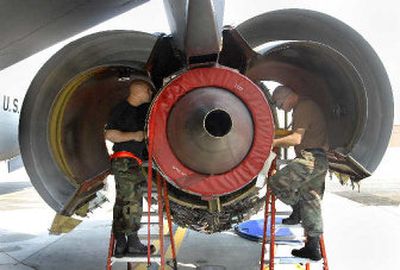Still nifty at fifty

Maintaining 40-plus-year-old planes is a demanding job.
But Staff Sgt. Wesley Foster, a Fairchild Air Force Base crew chief, knows that the work he and other airmen do to keep KC-135 tankers in top shape is integral to the base’s air refueling mission.
Fairchild’s 35 aging tankers “are as safe as a new airplane that rolls off the line,” Foster said.
Fairchild is celebrating the 50th anniversary of the KC-135 Stratotanker’s first flight in 1956, and on Wednesday took about 30 community leaders on a refueling mission.
“The KC-135 aircraft has been a significant part of the Air Force’s history since its inception,” said Fairchild Wing Commander Col. Scott Hanson.
The first tanker arrived at Fairchild in 1958, but Spokane has an even earlier place in air refueling history.
In 1929, a biplane named the Spokane Sun God, flew the first nonstop transcontinental roundtrip flight of 7,200 point-to-point miles. The trip required 11 in-air refuelings accomplished by hoses and – in some cases – five-gallon milk cans.
The KC-135 takes air refueling to a new level.
In just one minute, the plane can transfer as much fuel to another plane as it would take to run a typical passenger car for an entire year.
The KC-135 has been used in every U.S. armed conflict since the late 1950s, ranging from the Cold War and the Vietnam War to the first Gulf War and current homeland defense.
“If it was something important in history, there were KC-135s involved,” said base historian, retired Col. Dan Simmons.
The earliest KC-135, the KC-135A was replaced in the 1980s with the KC-135R, which has larger engines, is more fuel-efficient and can carry more fuel.
The tanker can be used for other purposes, as well, such as transporting cargo and troops or evacuating injured airmen.
Still, the Air Force would like to begin replacing the KC-135 with a more modern tanker.
“When you think about the future of Fairchild, the replacement of the tankers, it’s key,” said Rep. Cathy McMorris.
McMorris recently met with Air Force Gen. Duncan McNabb, commander of Air Mobility Command at Fairchild. She said McNabb told her the first new tankers would be assigned to Fairchild.
An earlier replacement attempt was derailed in 2004 by a scandal involving the Air Force employee charged with negotiating the tanker lease contract with Boeing. Darleen A. Druyan was negotiating an executive job with Boeing at the same time as the contract.
Hanson said the Air Force is planning to issue a request for proposals this fall.
Money for tanker research and development is up in the air, however. The U.S. House of Representatives included it in its 2007 defense appropriations, but the U.S. Senate did not.
McMorris said she’s hopeful the standoff will be resolved, saying it’s time that a program to replace the tankers began.
“Those tankers have decades to go before they’re worn out,” said Winslow Wheeler, director of the Straus Military Reform Project at the Center for Defense Information and a former U.S. Senate and U.S. General Accounting Office national security advisor.
Aircraft don’t age the same way automobiles do, and the KC-135 is still very effective, said Wheeler. In 2001, the Department of Defense said the tanker fleet would be structurally viable until 2040.
Wheeler said the Air Force shouldn’t rush the replacement process, and added that contractors like Boeing are trying to push the Air Force to buy new planes by playing on the public’s prejudices about older aircraft being inferior.
So far Boeing and Northrop Grumman-EADS, the majority owner of Airbus, are the contenders for the tanker contract.
Boeing officials have said they would build a new tanker in Everett. Northrop Grumman-EADS has indicated it would likely build tankers in Alabama.
Wheeler said domestic politics and discussion of economic development shouldn’t – but likely will – be part of the discussion when it comes to choosing a contractor.
“If Airbus submits the best proposal, we should buy it,” Wheeler said. “The purpose of the military equipment is not to produce jobs; it’s to have an effective military.”
What remains clear is that the KC-135 is going to be in service for quite some time. The earliest a new tanker might roll off the assembly line is 2011, and it would take years to replace the Air Force’s entire fleet of KC-135s.